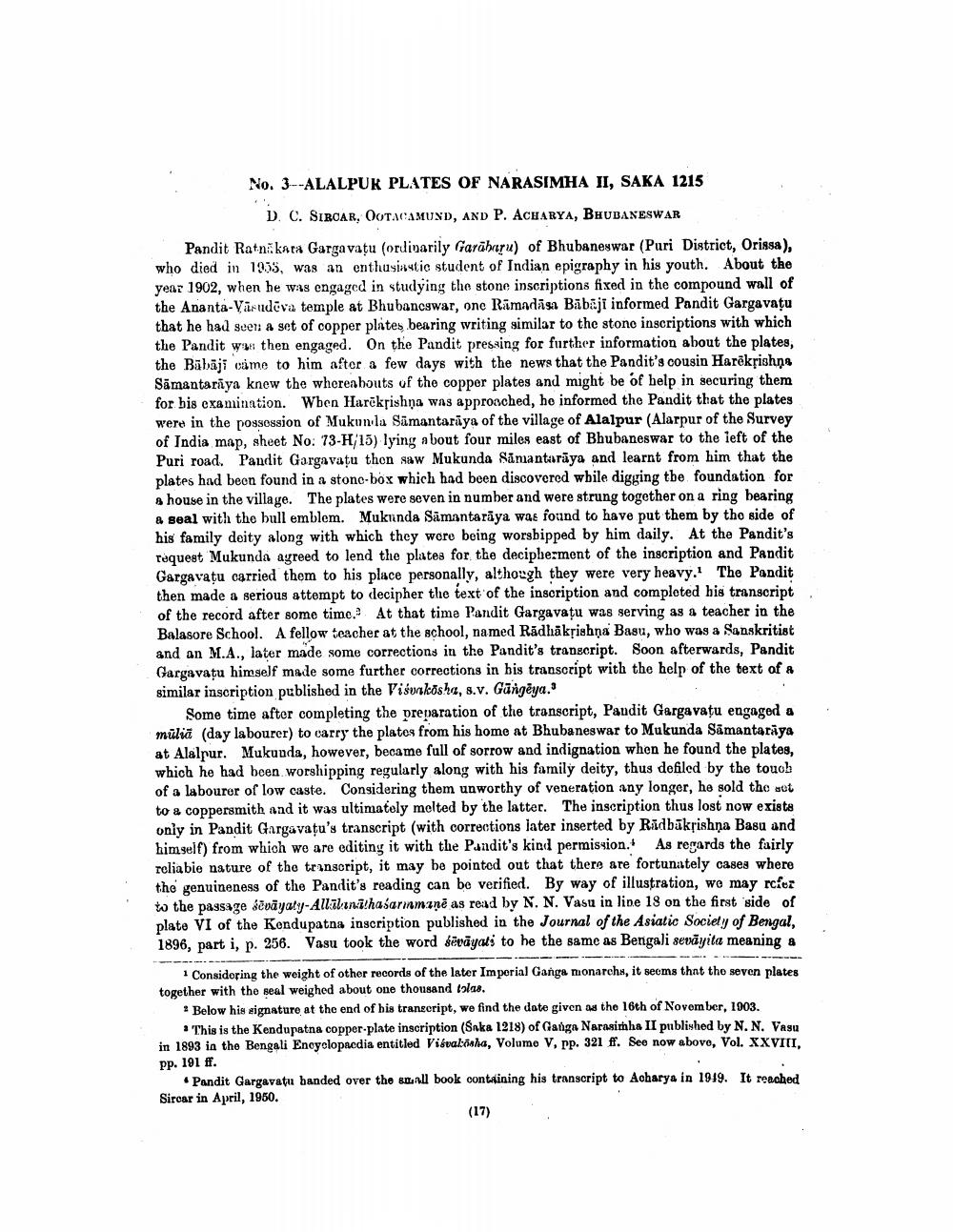________________
No. 3--ALALPUK PLATES OF NARASIMHA II, SAKA 1215
D. C. SIROAR, OOTACAMUND, AND P. ACHARYA, BHUBANESWAR Pandit Ratna kara Gargavatu (ordinarily Garābaru) of Bhubaneswar (Puri District, Orissa), who died in 1995, was an enthusiastic student of Indian epigraphy in his youth. About the year 1902, when he was engaged in studying the stone inscriptions fixed in the compound wall of the Ananta-Vasudeva temple at Bhubancgwar, one Ramadāsa Bābāji informed Pandit Gargavatu that he had seen a set of copper plates bearing writing similar to the stone inscriptions with which the Pandit was then engaged. On the Pandit pressing for further information about the plates, the Bäbāji came to him after a few days with the news that the Pandit's cousin Harēkrishng Sämantarāya knew the whereabouts of the copper plates and might be of help in securing them for bis examination. When Harēksishna was approached, ho informed the Pandit that the plates were in the possession of Mukun la Sämantariya of the village of Alalpur (Alarpur of the Survey of India map, sheet No: 73-H/15) lying about four miles east of Bhubaneswar to the ieft of the Puri road. Pandit Gargavatu then saw Mukunda Sämantariya and learnt from him that the plates had been found in a stone-box which had been discovered while digging the foundation for s house in the village. The plates were seven in number and were strung together on a ring bearing A seal with the bull emblem. Muknnda Samantarāya was found to have put them by the side of his family deity along with which they were being worshipped by him daily. At the Pandit's request Mukunda agreed to lend the plates for the decipherment of the inscription and Pandit Gargavatu carried them to his place personally, although they were very heavy.1 The Pandit then made a serious attempt to decipher the text of the inscription and completed his transcript of the record after some time. At that time Pandit Gargavatu was serving as a teacher in the Balasore School. A fellow teacher at the school, named Radhakrishna Basu, who was a Sanskritist and an M.A., later made some corrections in the Pandit's transcript. Soon afterwards, Pandit Gargavatu himself made some further corrections in his transcript with the help of the text of & similar inscription published in the Viswakosha, s.v. Güngėya.
Some time after completing the preparation of the transcript, Pandit Gargavatu engaged a mülia (day labourer) to carry the platos from his home at Bhubaneswar to Mukunda Sämantariya at Alalpur. Mukunda, however, became full of sorrow and indignation when he found the plates, which he had been worshipping regularly along with his family deity, thus dofiled by the touch of a labourer of low caste. Considering them unworthy of veneration any longer, he sold the sot to a coppersmith and it was ultimately melted by the latter. The inscription thus lost now exista only in Pandit Gargavatu's transcript (with corrections later inserted by Ridbūkrishna Basu and himself) from which we are editing it with the Pandit's kind permission. As regards the fairly reliabie nature of the transcript, it may be pointed out that there are fortunately cases where the genuineness of the Pandit's reading can be verified. By way of illustration, we may rciez to the passage sevāyaty-Alūlini hasarımınë as read by N. N. Vasu in line 18 on the first side of plate VI of the Kendupatna inscription published in the Journal of the Asiatic Society of Bengal, 1896, part i, p. 256. Vasu took the word tēvāyats to he the same as Bengali sevāyita meaning a
Considoring the weight of other records of the later Imporial Ganga monarchs, it seoms that the seven plates together with the seal weighed about one thousand tolas.
? Below his signature at the end of his transcript, we find the date given as the 16th of November, 1903.
* This is the Kendapatna copper-plate inscription (Saka 1218) of Ganga Narasimha II published by N. N. Vasu in 1893 in the Bengali Encyclopaedia entitled Visvakosha, Volume V, pp. 321 ff. See now above, Vol. XXVIII, Pp. 191 ff.
Pandit Gargavatu handed over the small book containing his transcript to Acharya in 1919. It reached Sircar in April, 1950.
(17)




